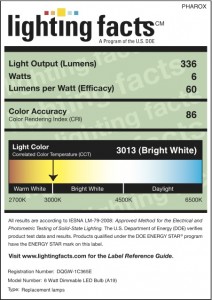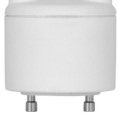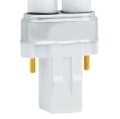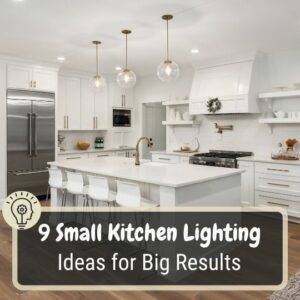 The type of light bulbs that you install in recessed lighting plays a major role in achieving your desired results.
The type of light bulbs that you install in recessed lighting plays a major role in achieving your desired results.
This post will explain how light bulbs are categorized and the differences between them. I’ve also included recommendations and a light bulb comparison chart that’s organized by fixture size and bulb type.
Note: It’s worth mentioning that technically the correct term for a light bulb is a lamp. That being said, light bulb is more commonly used and I use both terms interchangeably.
Light bulbs are categorized by the following:
Type
The four light bulb types used in residential recessed lighting are incandescent, halogen, compact fluorescent (CFL), and light emitting diode (LED).
 Incandescent aka traditional light bulbs are the oldest and least efficient technology.
Incandescent aka traditional light bulbs are the oldest and least efficient technology.
Electrical current passes through a tiny wire (filament) causing it get hot and glow. On average only 10% of the energy they consume is converted to light, with the remaining 90% being converted to heat.
 Halogen light bulbs are a type of incandescent lamp. The difference is that the filament inside the lamp is enclosed in a small quartz capsule which contains a halogen gas. Halogen lamps burn brighter (and hotter), and last longer than traditional incandescent bulbs.
Halogen light bulbs are a type of incandescent lamp. The difference is that the filament inside the lamp is enclosed in a small quartz capsule which contains a halogen gas. Halogen lamps burn brighter (and hotter), and last longer than traditional incandescent bulbs.
 Compact Fluorescent Lamps (CFL) are a very energy-efficient alternative to incandescent lamps. They use a gas-filled tube that is twisted or folded in a compact way that allows it to be as long as possible while taking up the same space as a standard light bulb. As electricity flows through the gas in the tube, a phosphor coating on the inside of the tube emits light.
Compact Fluorescent Lamps (CFL) are a very energy-efficient alternative to incandescent lamps. They use a gas-filled tube that is twisted or folded in a compact way that allows it to be as long as possible while taking up the same space as a standard light bulb. As electricity flows through the gas in the tube, a phosphor coating on the inside of the tube emits light.
CFLs require a ballast to regulate the current flowing through them which is either attached to the lamp itself (self-ballasted) or integrated into a dedicated fixture. Compact fluorescent lamps contain a very small amount of mercury.
 Light Emitting Diode (LED) light bulbs are the newest technology in lighting, and are replacing fluorescent lamps as the standard in energy-efficient lighting.
Light Emitting Diode (LED) light bulbs are the newest technology in lighting, and are replacing fluorescent lamps as the standard in energy-efficient lighting.
To put it simply, LEDs are semiconductors that emit light as current passes through them. Benefits include an extremely long life, dimmable, they do not contain mercury, and even better efficiency than CFLs.
Shape
The shape of the light bulb is what determines the direction of the light emitted from it. In the U.S., we use a standardized letter code system that refers to the shape.
 R (Reflector) bulbs are the most common shape bulb used in recessed lighting. As their name suggests, they have a reflective surface inside which directs all of the light in one direction (downward). This prevents wasted light that would otherwise be shining upward into the recessed fixture, and allows for control over the beam angle of the light coming from the bulb.
R (Reflector) bulbs are the most common shape bulb used in recessed lighting. As their name suggests, they have a reflective surface inside which directs all of the light in one direction (downward). This prevents wasted light that would otherwise be shining upward into the recessed fixture, and allows for control over the beam angle of the light coming from the bulb.
 BR (Bulged Reflector) lamps are a new and improved version of the reflector lamp. The primary difference is the “bulge” near the base of the lamp. This shape focuses more light into the beam of light to direct it out of the recessed fixture.
BR (Bulged Reflector) lamps are a new and improved version of the reflector lamp. The primary difference is the “bulge” near the base of the lamp. This shape focuses more light into the beam of light to direct it out of the recessed fixture.
 PAR (Parabolic Aluminized Reflector) lamps use a parabolic shaped reflective surface which produces a tighter, more controlled beam of light than standard reflector bulbs. PAR bulbs are commonly used in stage and theatrical lighting, as well as in the home for accent and art lighting.
PAR (Parabolic Aluminized Reflector) lamps use a parabolic shaped reflective surface which produces a tighter, more controlled beam of light than standard reflector bulbs. PAR bulbs are commonly used in stage and theatrical lighting, as well as in the home for accent and art lighting.
 MR (Multifaceted Reflector) lamps have a reflective inner surface that is covered in facets which gathers and shapes the light into a tightly controlled beam.
MR (Multifaceted Reflector) lamps have a reflective inner surface that is covered in facets which gathers and shapes the light into a tightly controlled beam.
 Tube, Spiral, or Twist shapes are used with compact fluorescent lamps. The shape allows for the necessary tube length to be folded into a compact shape the size of the light bulb it is intended to replace. By themselves they are omnidirectional. However, there is a reflector version of them in which the tube is inside a reflector shell.
Tube, Spiral, or Twist shapes are used with compact fluorescent lamps. The shape allows for the necessary tube length to be folded into a compact shape the size of the light bulb it is intended to replace. By themselves they are omnidirectional. However, there is a reflector version of them in which the tube is inside a reflector shell.
 A (Arbitrary) lamps are the most common household lamp. They are omnidirectional.
A (Arbitrary) lamps are the most common household lamp. They are omnidirectional.
Size
 In the U.S., the size (diameter) of a light bulb is expressed using a numerical code that represents 1/8ths of an inch.
In the U.S., the size (diameter) of a light bulb is expressed using a numerical code that represents 1/8ths of an inch.
For example, an MR16 lamp is 16 “1/8ths” of an inch or 16/8 = 2 inches in diameter.
Base
There are 6 types of light bulb bases commonly used in recessed fixtures.
Self-ballasted CFL
 Fluorescent lamps require a ballast to regulate the current flowing to them. Originally, this meant that you could only use a fluorescent lamp in a fluorescent fixture because the fixture contained the required ballast. This made it impossible to use an energy-efficient fluorescent light bulb in a standard (non-fluorescent) light fixture.
Fluorescent lamps require a ballast to regulate the current flowing to them. Originally, this meant that you could only use a fluorescent lamp in a fluorescent fixture because the fixture contained the required ballast. This made it impossible to use an energy-efficient fluorescent light bulb in a standard (non-fluorescent) light fixture.
To solve this problem, manufacturers began offering CFL lamps with miniature built-in ballasts and standard screw bases which allowed the bulb to be used in any standard fixture.
Self-driven LED
 Similar to fluorescents, LEDs require a driver to regulate the voltage/current flowing to the diode.
Similar to fluorescents, LEDs require a driver to regulate the voltage/current flowing to the diode.
Generally speaking, screw-base LED bulbs will have a have built-in driver and are designed to be used in any standard base recessed fixture. Plug and pin-based LED light bulbs require a dedicated LED recessed fixture that has a driver.
Performance
The performance specifications of a lamp are easier than ever to understand, thanks to the standardized Lighting Facts label now included on the packaging of all light bulbs.
The items included on the labels may vary. Below are examples from two different manufacturers, as well as an explanation of all of the items that could be listed on a label:
 Light Output (Brightness) is given in lumens which, in simple terms, is a measurement of the amount of light contained in an area.
Light Output (Brightness) is given in lumens which, in simple terms, is a measurement of the amount of light contained in an area.
Light output is measured in a laboratory using standardized testing methods but for our use, it is more or less just a number used to compare one lamp’s brightness to another.
Watts (Energy Used) is the amount of energy used to light the bulb.
Yearly Energy Cost is an estimated figure based on 3 hours of use per day at an average kilowatt rate.
Life is given in years and is based on 3 hours of use per day.
 Color Accuracy is based on the Color Rendering Index (CRI) which measures a lamp’s ability to display colors accurately. It is based on a scale with 100 being perfect. Anything above 90 is considered excellent.
Color Accuracy is based on the Color Rendering Index (CRI) which measures a lamp’s ability to display colors accurately. It is based on a scale with 100 being perfect. Anything above 90 is considered excellent.
Light Appearance (Color) refers to the color temperature of the light which is measured in kelvins (K). The lower the number, the warmer the appearance.
A final factor to consider is whether or not the lamp is dimmable. That information may not be on the Lighting Facts Label itself, but should be found somewhere on the packaging.
Recommended Light Bulb Types for Recessed Lighting
General Lighting
Recommendation: BR30 or BR40 lamps with a CRI greater than 90 and a Color Temperature of 3000K or less.
Your general lighting layer will be providing the overall illumination for your room. The lamps need to be bright and have a wide beam angle for coverage, which is why BR lamps are ideal.
The color of the light is also important for general lighting. Color temperatures above 3200K can make a room feel cold and stark (think dentist office).
Task Lighting
Recommendation: PAR20 or PAR30 lamps with a CRI greater than 90.
Task lighting should provide nice controlled light right where you need it, and this is precisely what PAR lamps are designed to do.
Accent Lighting
Recommendation: MR16 or PAR lamps with a CRI greater then 90, Color Temperature of 2800-3100, and Dimmable.
Color rendering, color temperature, and beam control are essentials for accent lighting, especially artwork. MR16 lamps are ideal in all three areas which makes them the perfect choice for accent lighting.
Note: Most halogen MR lamps have a glass lens covering the halogen quartz capsule which filters the small amount of ultraviolet light emitted from the lamp. If you are using a lamp without a glass lens, be sure to use a filter in your trim to block any UV rays that could potentially damage artwork.
Below is a chart with my recommended lamp types for recessed lighting and their specifications. They are separated (color coded) by fixture size and type.
| Lamp | Brightness (lumens) | Energy (Watts) | Color Temp (Kelvin) | CRI | Life (Years) | Dimmable | Instant On |
| MR16 Halogen | 380-430 | 50 | 2800-3100 | 100 | 2-4 | Yes | Yes |
| MR16 LED | 320-440 | 5-9 | 2700-6500 | 65-95 | 25+ | Some | Yes |
| BR20 Incandescent | 410-440 | 50 | 2700 | 100 | 1-3 | Yes | Yes |
| BR20 CFL | 450-550 | 11-14 | 2700-6500 | 80-90 | 5-9 | No | Delay |
| BR20 LED | 320-550 | 5-11 | 2700-6500 | 65-95 | 25+ | Most | Yes |
| PAR20 Halogen | 550-570 | 50 | 3000 | 100 | 2-4 | Yes | Yes |
| PAR20 LED | 320-550 | 5-11 | 2700-6500 | 65-95 | 25+ | Most | Yes |
| BR30 Incandescent | 650-700 | 65 | 2700 | 100 | 1-3 | Yes | Yes |
| BR30 CFL | 670-750 | 14-16 | 2700-6500 | 80-90 | 5-9 | No | Delay |
| BR30 LED | 570-800 | 11-15 | 2700-6500 | 65-95 | 25+ | Most | Yes |
| PAR30 Halogen | 1030-1100 | 75 | 3000 | 100 | 2-4 | Yes | Yes |
| PAR30 LED | 620-720 | 11-15 | 2700-6500 | 65-95 | 25+ | Most | Yes |
| PAR38 Halogen | 1030-1100 | 75 | 3000 | 100 | 2-4 | Yes | Yes |
| PAR38 LED | 1050-1150 | 15-24 | 2700-6500 | 65-95 | 25+ | Most | Yes |
| BR40 Incandescent | 650-700 | 65 | 2700 | 100 | 1-3 | Yes | Yes |
| BR40 CFL | 1050-1200 | 23 | 2700-6500 | 80-90 | 5-9 | No | Delay |
| BR40 LED | 950-1200 | 15-24 | 2700-6500 | 65-95 | 25+ | Most | Yes |
| 4″ Low Voltage Fixtures | 4″ Standard Fixtures | 5″ or 6″ Fixtures | 6″ Fixtures |
Note: When you look closely at the chart it should be apparent why LEDs are destined to replace all other types of lamps.












